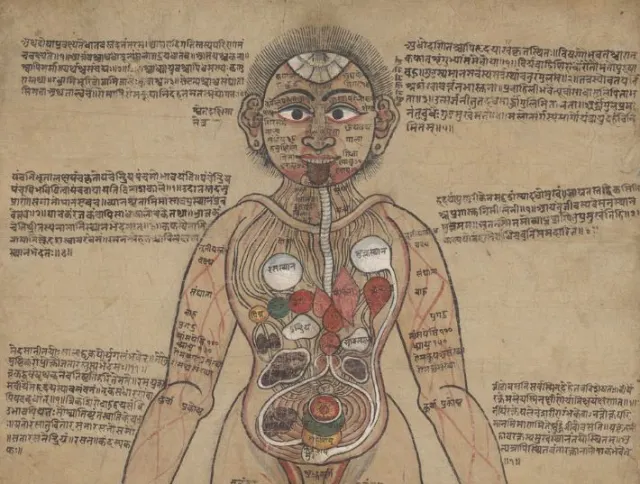
Ayurvedic Man: Ancient understandings of medicine

An Indian person in a yogic posture, gouache painting, 19th Century. Wellcome Library, London.
Ideas about alternative medicine are deeply embedded in Western culture today – whether in the form of yoga, massage, herbal remedies or discussions about mindfulness and wellness – but the principles that underlie them are less well understood. An exhibition at London’s Wellcome Collection, which opened this month, aims to shed light on the ancient Indian practice of Ayurveda, from which many of these ideas originate.
In examining these centuries-old, but ever-evolving, set of practices, Ayurvedic Man: Encounters with Indian Medicine explores the relationship between healthcare and cultural values, as well as the movement and evolution of medical knowledge across continents and over time.

Sanskrit manuscript from the karma vipāka genre, meaning ‘the ripening of karma’, 1469
Perhaps more intriguingly, the exhibition also considers the role of the collector in shaping our understanding of history and global culture. The word “encounters” in the show’s title makes this explicit – the Wellcome Collection is trying to address questions about interpretation, often by Western researchers of Eastern cultures, and how ideas can be altered, exploited, exoticised and commodified, especially because of its own role in gathering the objects on display.
In fact, this display focuses heavily on the institution’s own collection – in particular, the objects collected by Paira Mall, a doctor who was sent to India in 1911 for a decade to gather knowledge and source material for its founder Henry Wellcome, a pharmaceuticals magnate who had an eye on the commercial potential of these findings. Mall’s correspondence with CJS Thompson, the curator of Wellcome’s Historical Medical Museum at the time, forms the show’s backbone, and various themes – such as the Ayurvedic understanding of the body and of sickness; the discovery, use and exchange of botanical cures; and the gender gaps in medical knowledge – are explored along the way.

The holy Cow personified as World Mother with many Sanskrit verses
The influence of the British colonial administration on Indian healthcare and the tensions that emerged between western and eastern medicine, are explored through photographs and documents that record the handling of disease, inoculation and public health. A newly commissioned artwork by artist Ranjit Kandalgaonkar, produced during a residency at London’s Gasworks studios, takes this further. He has produced a large-scale detailed drawing reimagining the “combative and often draconian measures” imposed by the colonial authorities in response to the outbreak of plague in Bombay in 1896, in an effort to highlight how disease, and misconceptions about it, can persist and spread. An accompanying interactive digital platform allows visitors to access additional material from the Wellcome Collection’s library and the Asiatic Library in Mumbai, including cartoons from the satirical magazine Hindi Punch lampooning the government and bourgeois attitudes during the time.

The Ayurvedic Man, pen and watercolour, 18th Century. Wellcome Library, London.
The star of the show, the “Ayurvedic man” that lends it its name, is an 18th century Nepali painting showing the organs and vessels of the male body – displayed alongside a soundtrack of a voice reading out the Sanskrit description of the body surrounding it. Its journey from Nepal via India to the Wellcome Library through an art dealer illustrates the longstanding fascination that Europeans have had with Indian medicine. It’s just one of a rich collection of manuscripts, gouache paintings, erotic manuals and surgical tools in display, including a Persian watercolour painting linking body parts to zodiac symbols and a Tibetan body map depicting the chakras.

Illustration showing a Zodiac Man, with Persian annotations, Diagram in the Tashrīh-i Manṣūrī style, watercolour, 19th century
Finally, a new film by Nilanjan Bhattacharya focuses on two local practitioners in separate parts of India, discussing and considering the challenges of keeping these medical traditions alive today. While most of the exhibition looks to the past, this nod the future is a reminder that these are living practices that are at risk, hinting that the evolution of Ayurveda is far from over.





